Influence of Strain Hardening Rate of Material on Temperature and Strain Distributions during Wire Drawing
Abstract
1. Introduction
2. Experiment and FEA
2.1. Experiment
2.2. FEA
3. Validation of FEA Model
4. Results
4.1. Temperature Distribution
4.2. Strain Distribution
4.3. Stress, Damage Value, and Drawing Force
5. Discussion
6. Conclusions
- The temperature increase of the wire augmented as the n of the specimen increased despite the same amount of ideal plastic deformation, which is associated closely with redundant work. The shear strain increased with the n of the specimen, and this shear strain generated redundant work, leading to a high temperature rise.
- The drawing force increased with the n of the wire during wire drawing, which is related to the high redundant work with increasing n of the wire. In addition, the drawing force varied linearly with the temperature rise of the wire.
- The damage value in the center region of the wire reduced with increasing n of the wire during wire drawing, because the effective stress increased with increasing the n of the wire
- The drawing speed should be reduced and/or the cooling of wire and die should be strengthened during wire drawing with increasing n value of the wire, because product quality and die wear are highly associated with the temperature rise of the wire in the deformation zone.
- From the results of the present study, engineers need to choose optimum drawing condition based on the variation of the drawing force and wire temperature with process conditions and materials. However, it is not easy to present quantitative suggestions for engineers based on the results of this study. Further research under more industrially specific conditions is required to design the optimum wire-drawing process with n value of material.
Funding
Institutional Review Board Statement
Informed Consent Statement
Data Availability Statement
Conflicts of Interest
References
- Lee, S.K.; Lee, S.B.; Kim, B.M. Process design of multi-stage wet wire drawing for improving the drawing speed for 0.72 wt% C steel wire. J. Mater. Process. Technol. 2010, 210, 776–783. [Google Scholar] [CrossRef]
- Lee, S.K.; Kim, D.W.; Jeong, M.S.; Kim, B.M. Evolution of axial surface residual stress in 0.82 carbon steel wire during multi pass drawing process considering heat generation. Mater. Des. 2012, 34, 363–371. [Google Scholar] [CrossRef]
- Lee, S.K.; Ko, D.C.; Kim, B.M. Pass schedule of wire drawing process to prevent delamination for high strength steel cord wire. Mater. Des. 2009, 30, 2919–2927. [Google Scholar] [CrossRef]
- Jo, H.H.; Lee, S.K.; Kim, M.A.; Kim, B.M. Pass schedule design system in the dry wire-drawing process of high carbon steel. Proc. Inst. Mech. Eng. Part B J. Eng. Manuf. 2002, 216, 365–373. [Google Scholar] [CrossRef]
- Haddi, A.; Imad, A.; Vega, G. Analysis of temperature and speed effects on the drawing stress for improving the wire drawing process. Mater. Des. 2011, 32, 4310–4315. [Google Scholar] [CrossRef]
- Cetinarslan, C.S.; Guzey, A. Tensile properties of cold-drawn low-carbon steel wires under different process parameters. Mater. Technol. 2013, 47, 245–252. [Google Scholar]
- Vega, G.; Haddi, A.; Imad, A. Temperature effects on wire-drawing process: Experimental investigation. Int. J. Mater. Form. 2009, 2, 229–232. [Google Scholar] [CrossRef]
- Suliga, M.; Kruzel, R.; Garstka, T.; Gazdowicz, J. The influence of drawing speed on structure changes in high carbon steel wires. Metalurgija 2015, 54, 161–164. [Google Scholar]
- Pilarczyk, J.W.; Markowski, J.; Dyja, H.; Golis, B. FEM modeling of drawing of wires for prestressed concrete. Wire J. Int. 2004, 37, 118–123. [Google Scholar]
- Nemec, I.; Golis, B.; Pilarczyk, J.W.; Budzik, R.; Waszkielewicz, W. Effect of high-speed drawing on properties of high-carbon steel wires. Wire J. Int. 2007, 40, 63–68. [Google Scholar]
- Zhang, G.L.; Wang, Z.W.; Zhang, S.H.; Cheng, M.; Song, H.W. A fast optimization approach for multipass wire drawing processes based on the analytical model. Proc. Inst. Mech. Eng. Part B J. Eng. Manuf. 2013, 227, 1023–1031. [Google Scholar] [CrossRef]
- Hwang, J.K. Effect of drawing speed on microstructure distribution and drawability in twinning-induced plasticity steel during wire drawing. J. Iron Steel Res. Int. 2020, 27, 577–587. [Google Scholar] [CrossRef]
- El-Domiaty, A.; Kassab, S.Z. Temperature rise in wire-drawing. J. Mater. Process. Technol. 1998, 83, 72–78. [Google Scholar] [CrossRef]
- Dixit, U.S.; Dixit, P.M. An analysis of the steady-state wire drawing of strain-hardening materials. J. Mater. Process. Technol. 1995, 47, 201–229. [Google Scholar] [CrossRef]
- Atkins, A.G.; Caddell, R.M. The incorporation of work hardening and redundant work in rod drawing analyses. Int. J. Mech. Sci. 1968, 10, 15–28. [Google Scholar] [CrossRef]
- Shi, M.F.; Meuleman, D.J. On certain aspects of strain rate sensitivity of sheet metals. J. Mater. Eng. Perform. 1995, 4, 321–333. [Google Scholar] [CrossRef]
- Ghosh, A.K. Strain localization in the diffuse neck in sheet metal. Metall. Trans. 1974, 5, 1607–1616. [Google Scholar] [CrossRef]
- Tsuchida, N.; Inoue, T.; Enami, K. Estimations of the true stress and true strain until just before fracture by the stepwise tensile test and bridgman equation for various metals and alloys. Mater. Trans. 2012, 53, 133–139. [Google Scholar] [CrossRef]
- Yang, H.K.; Tian, Y.Z.; Zhang, Z.J.; Zhang, Z.F. Different strain rate sensitivities between Fe-22Mn-0.6C and Fe-30Mn-3Si-3Al twinning-induced plasticity steels. Mater. Sci. Eng. A 2016, 655, 251–255. [Google Scholar] [CrossRef]
- Shen, Y.F.; Jia, N.; Misra, R.D.K.; Zuo, L. Softening behavior by excessive twinning and adiabatic heating at high strain rate in a Fe-20Mn-0.6C TWIP steel. Acta Mater. 2016, 103, 229–242. [Google Scholar] [CrossRef]
- Hwang, J.K. Strain and strain rate hardening effects on the macroscopic shear bands and deformation shape of a caliber-rolled wire. J. Manuf. Process. 2022, 79, 102–114. [Google Scholar] [CrossRef]
- Lee, S.Y.; Lee, S.I.; Hwang, B. Effect of strain rate on tensile and serration behaviors of an austenitic Fe-22Mn-0.7C twinning-induced plasticity steel. Mater. Sci. Eng. A 2018, 711, 22–28. [Google Scholar]
- Paul, S.K. Non-linear correlation between uniaxial tensile properties and shear-edge hole expansion ratio. J. Mater. Eng. Perform. 2014, 23, 3610–3619. [Google Scholar] [CrossRef]
- De Maddi, M.; Spena, P.R. Plastic flow behavior of twinning induced plasticity steel from low to warm temperatures. J. Mater. Res. Technol. 2020, 9, 1708–1719. [Google Scholar] [CrossRef]
- Yu, H.Y.; Lee, S.M.; Nam, J.H.; Lee, S.J.; Fabregue, D.; Park, M.H.; Tsuji, N.; Lee, Y.K. Post-uniform elongation and tensile fracture mechanisms of Fe-18Mn-0.6C-xAl twinning-induced plasticity steels. Acta Mater. 2017, 131, 435–444. [Google Scholar] [CrossRef]
- Kim, S.J.; Lee, T.; Hwang, J.K. High-strength bolt manufactured by an extrusion-based forming process using twinning-induced plasticity steel. J. Manuf. Process. 2020, 59, 33–42. [Google Scholar] [CrossRef]
- Grassel, O.; Kruger, L.; Frommeyer, G.; Meyer, L.W. High strength Fe-Mn-(Al, Si) TRIP/TWIP steels development-properties-application. Int. J. Plast. 2000, 16, 1391–1409. [Google Scholar] [CrossRef]
- Bouaziz, O.; Allain, S.; Scott, C.P.; Cugy, P.; Barbier, D. High manganese austenitic twinning induced plasticity steels: A review of the microstructure properties relationships. Curr. Opin. Solid State Mater. Sci. 2011, 15, 141–168. [Google Scholar] [CrossRef]
- Hwang, J.K. The temperature distribution and underlying cooling mechanism of steel wire rod in the Stelmor type cooling process. Appl. Therm. Eng. 2018, 142, 311–320. [Google Scholar] [CrossRef]
- Wright, R.N. Wire Technology: Process Engineering and Metallurgy; Butterworth-Heinemann: Oxford, UK, 2011. [Google Scholar]
- Hwang, J.K.; Son, I.H.; Yoo, J.Y.; Zargaran, A.; Kim, N.J. Effect of reduction of area on microstructure and mechanical properties of twinning-induced plasticity steel during wire drawing. Met. Mater. Int. 2015, 21, 815–822. [Google Scholar] [CrossRef]
- Hasani, G.H.; Mahmudi, R.; Karimi-Taheri, A. On the strain inhomogeneity in drawn copper wires. Int. J. Mater. Form. 2010, 3, 59–64. [Google Scholar] [CrossRef]
- Cho, D.; Jang, Y.C.; Lee, Y. Evaluation of the prediction ability of ductile fracture criteria over a wide range of drawing conditions. J. Mech. Sci. Technol. 2019, 33, 4245–4254. [Google Scholar] [CrossRef]
- Moon, C.; Kim, N. Analysis of wire-drawing process with friction and thermal conditions obtained by inverse engineering. J. Mech. Sci. Technol. 2012, 26, 2903–2911. [Google Scholar] [CrossRef]
- Yang, H.K.; Zhang, Z.J.; Dong, F.Y.; Duan, Q.Q.; Zhang, Z.F. Strain rate effects on tensile deformation behaviors for Fe-22Mn-0.6C-(1.5Al) twinning-induced plasticity steel. Mater. Sci. Eng. A 2014, 607, 551–558. [Google Scholar] [CrossRef]
- Curtze, S.; Kuokkala, V.T. Dependence of tensile deformation behavior of TWIP steels on stacking fault energy, temperature and strain rate. Acta Mater. 2010, 58, 5129–5141. [Google Scholar] [CrossRef]
- Neu, R.W. Performance and characterization of TWIP steels for automotive applications. Mater. Perform. Charact. 2013, 2, 244–284. [Google Scholar] [CrossRef]
- Felder, E.; Levrau, C.; Mantel, M.; Truong Dinh, N.G. Identification of the work of plastic deformation and the friction shear stress in wire drawing. Wear 2012, 286–287, 27–34. [Google Scholar] [CrossRef]
- Cockcroft, M.G.; Latham, D.J. Ductility and the workability of metals. J. Inst. Met. 1968, 96, 33–39. [Google Scholar]
- Oh, S.I.; Chen, C.C.; Kobayashi, S. Ductile Fracture in Axisymmetric Extrusion and Drawing-Part 2: Workability in Extrusion and Drawing. J. Manuf. Sci. Eng. 1979, 101, 36–44. [Google Scholar] [CrossRef]
- Cao, T.S.; Bobadilla, C.; Montmitonnet, P.; Bouchard, P.O. A comparative study of three ductile damage approaches for fracture prediction in cold forming processes. J. Mater. Process. Technol. 2015, 216, 385–404. [Google Scholar] [CrossRef]
- Haddi, A.; Imad, A.; Vega, G. The influence of the drawing parameters and temperature rise on the prediction of chevron crack formation in wire drawing. Int. J. Fract. 2012, 176, 171–180. [Google Scholar] [CrossRef]
- Ko, D.C.; Kim, B.M. The prediction of central burst defects in extrusion and wire drawing. J. Mater. Process. Technol. 2000, 102, 19–24. [Google Scholar] [CrossRef]
- Mcallen, P.; Phelan, P. Ductile fracture by central bursts in drawn 2011 aluminium wire. Int. J. Fract. 2005, 135, 19–33. [Google Scholar] [CrossRef]
- Haghighat, H.; Parghazeh, A. An investigation into the effect of strain hardening on the central bursting defects in rod extrusion process. Int. J. Adv. Manuf. Technol. 2017, 93, 1127–1137. [Google Scholar] [CrossRef]
- Caddell, R.M.; Atkins, A.G. Optimum Die Angles and Maximum Attainable Reductions in Rod-Drawing. J. Eng. Ind. 1969, 9, 664–671. [Google Scholar] [CrossRef]
- Hollinger, S.; Depraetere, E.; Giroux, O. Wear mechanism of tungsten carbide dies during wet drawing of steel tyre cords. Wear 2003, 255, 1291–1299. [Google Scholar] [CrossRef]
- Fang, H.; Gao, L.; Zhou, X.; Yan, H.; Wang, Y.; Ji, H. Enhanced compressive strength of preheated limonite pellets with biomass-derived binders. Adv. Powder Technol. 2023, 34, 104154. [Google Scholar] [CrossRef]
- Cho, D.; Lee, Y. Development of a machine learning based fast running model to determine rapidly the process conditions in drawing process. Int. J. Automot. Technol. 2019, 20, 9–17. [Google Scholar] [CrossRef]
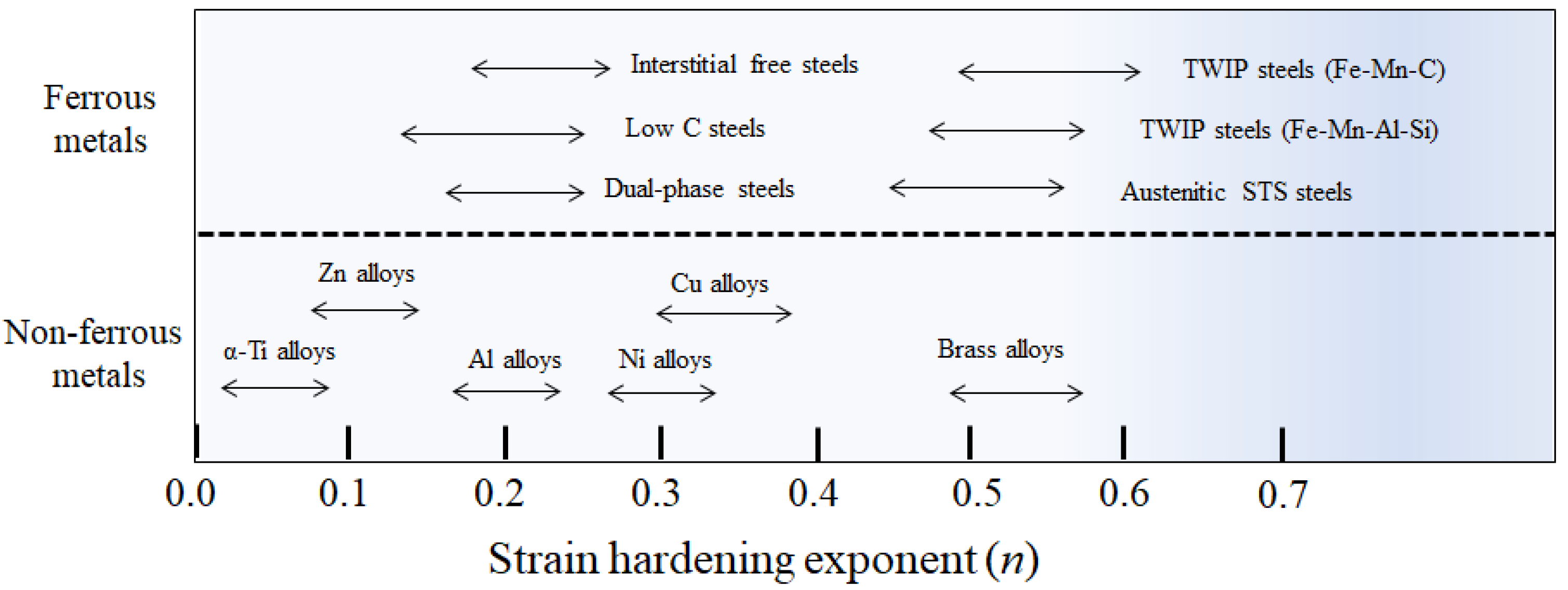


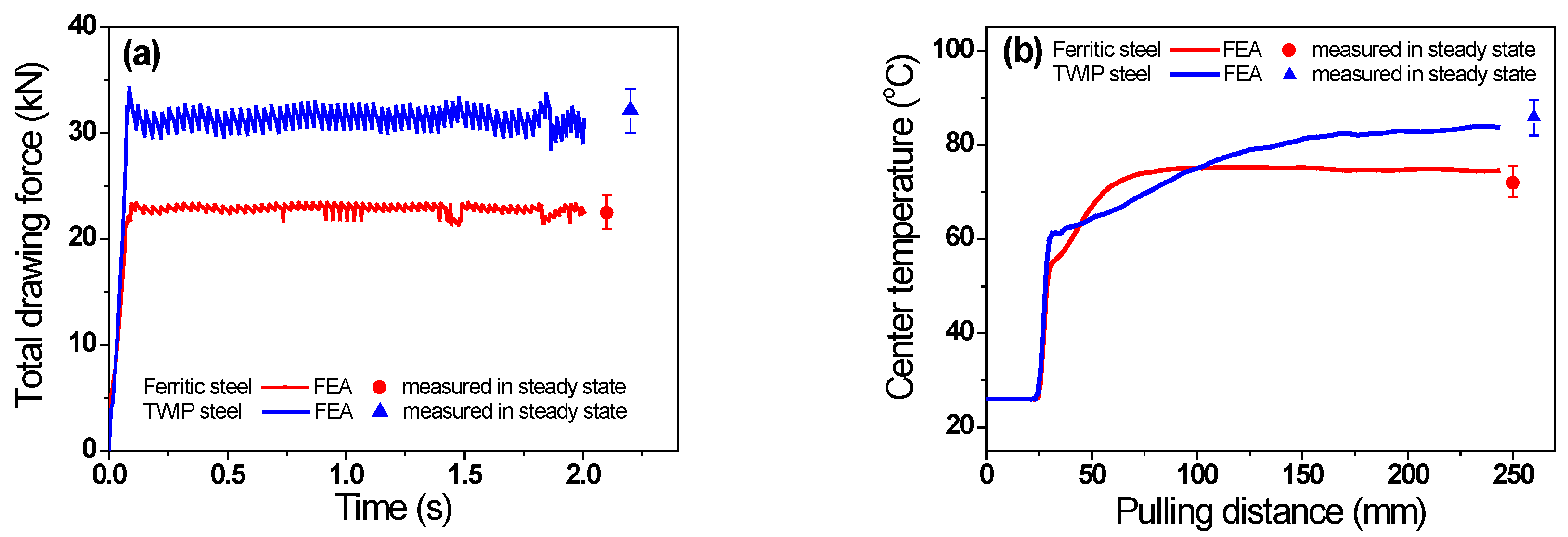
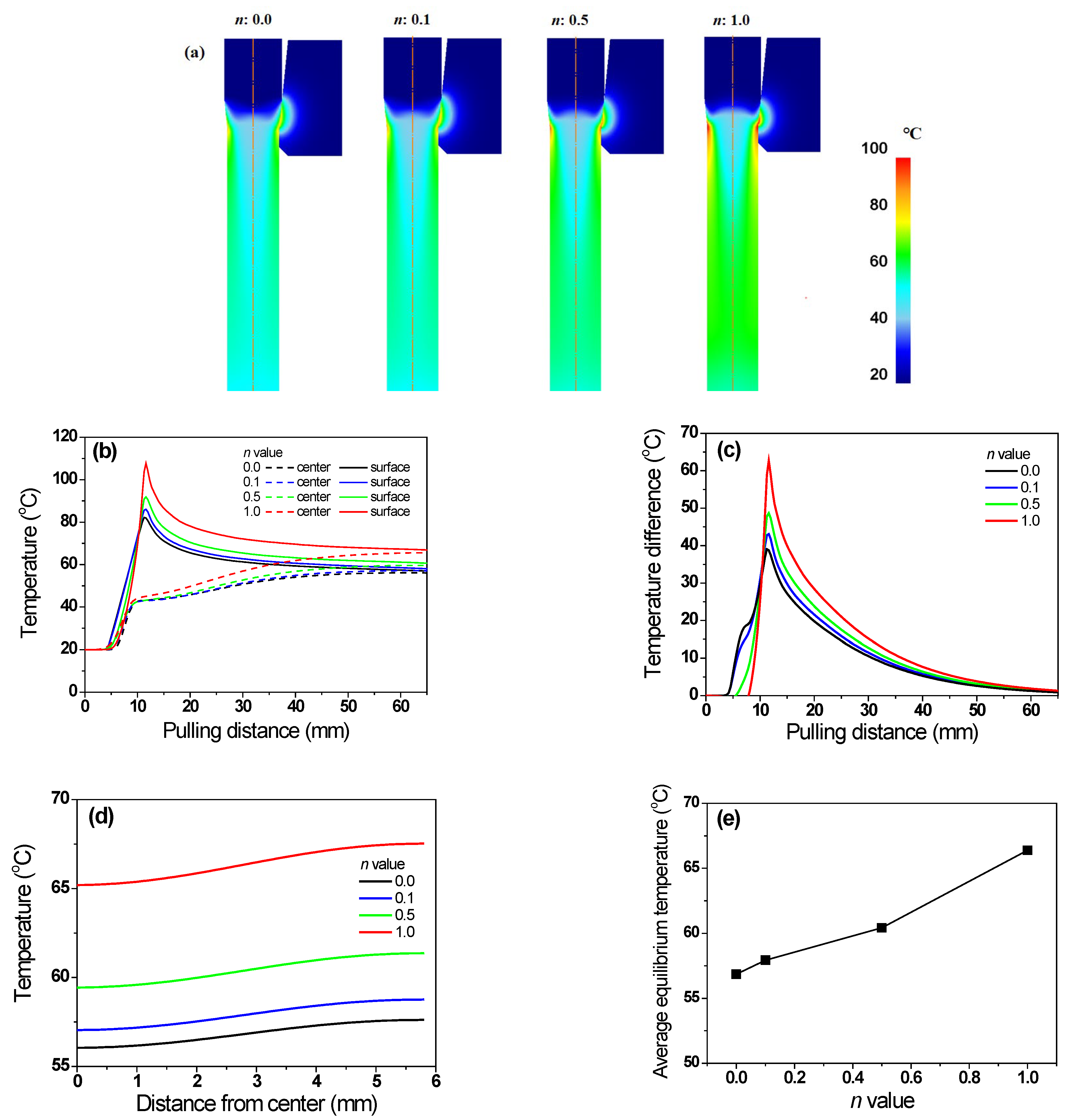

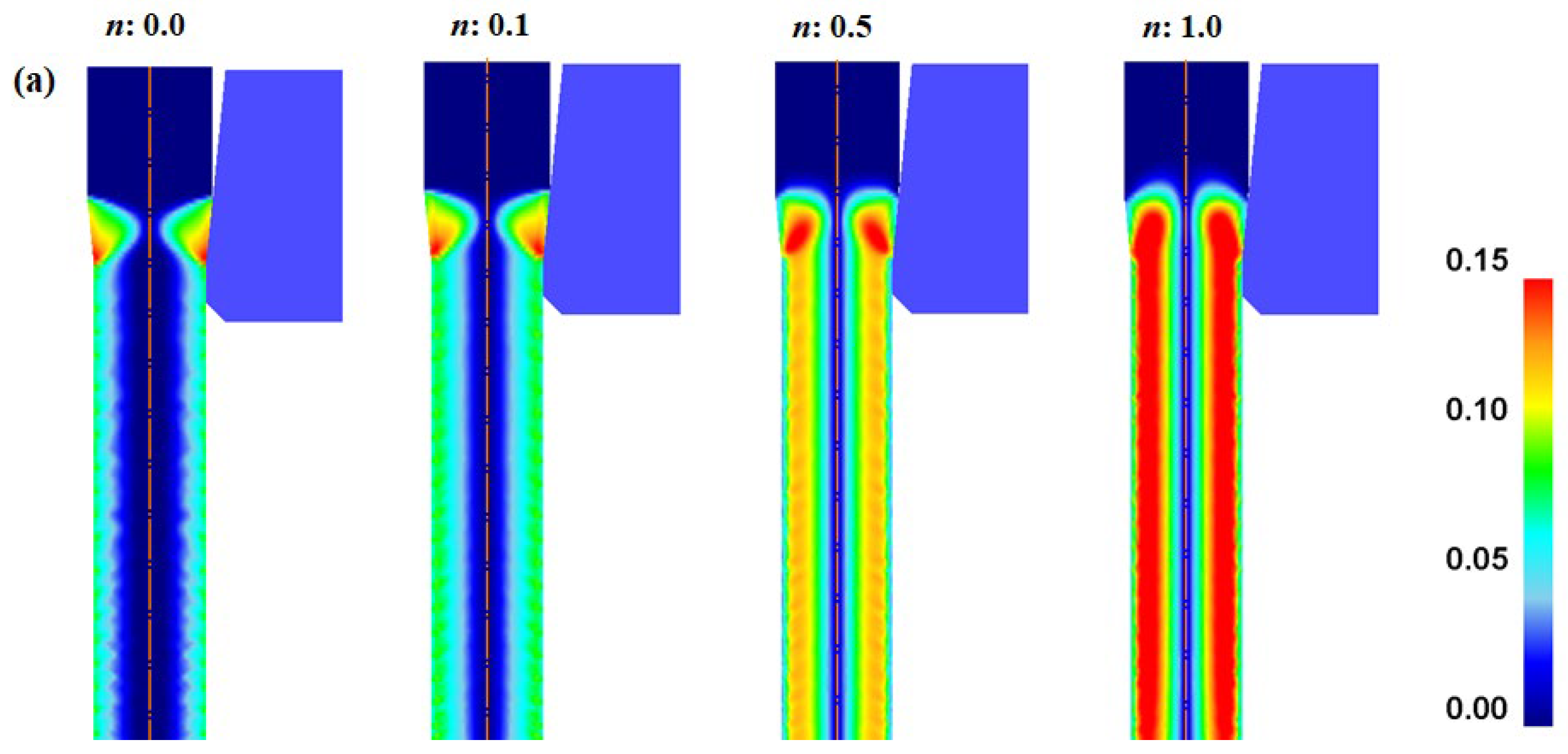
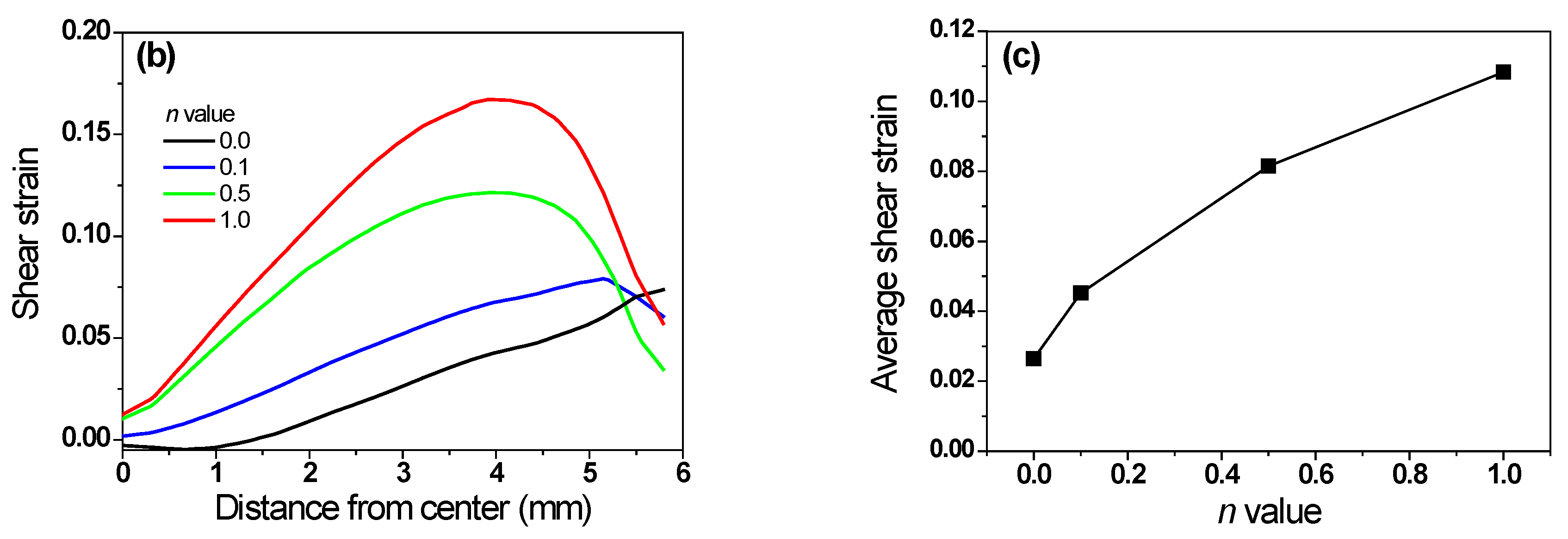
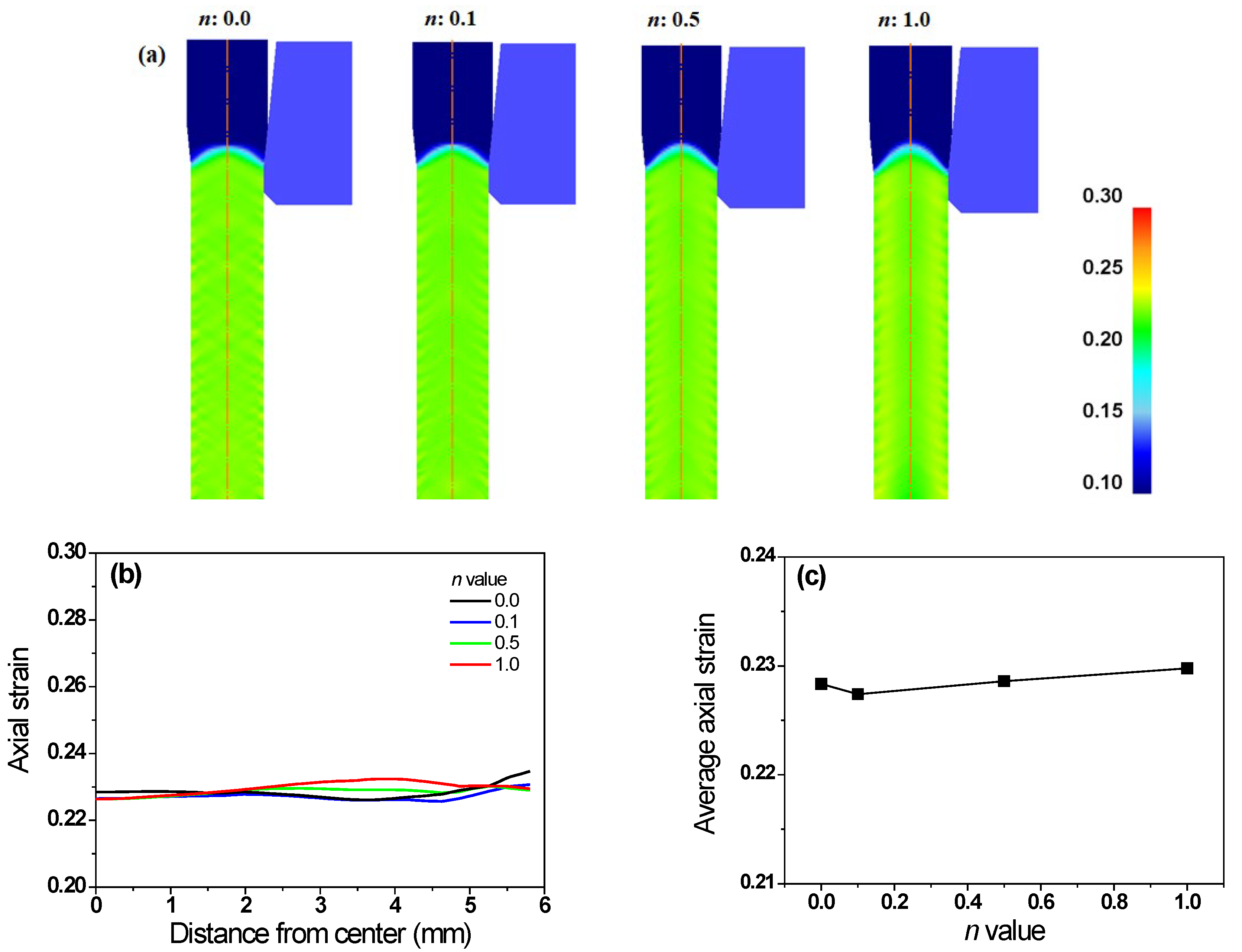
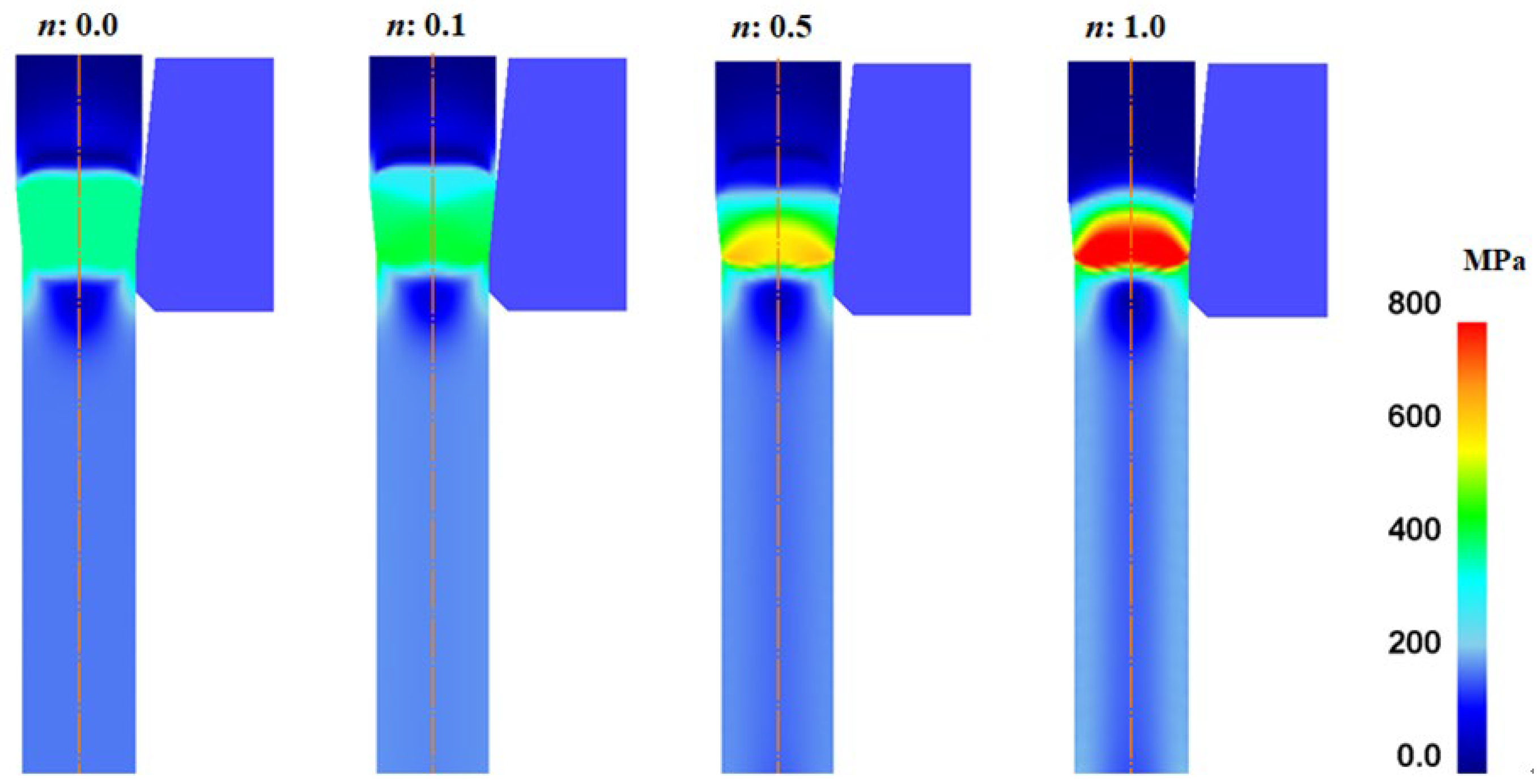

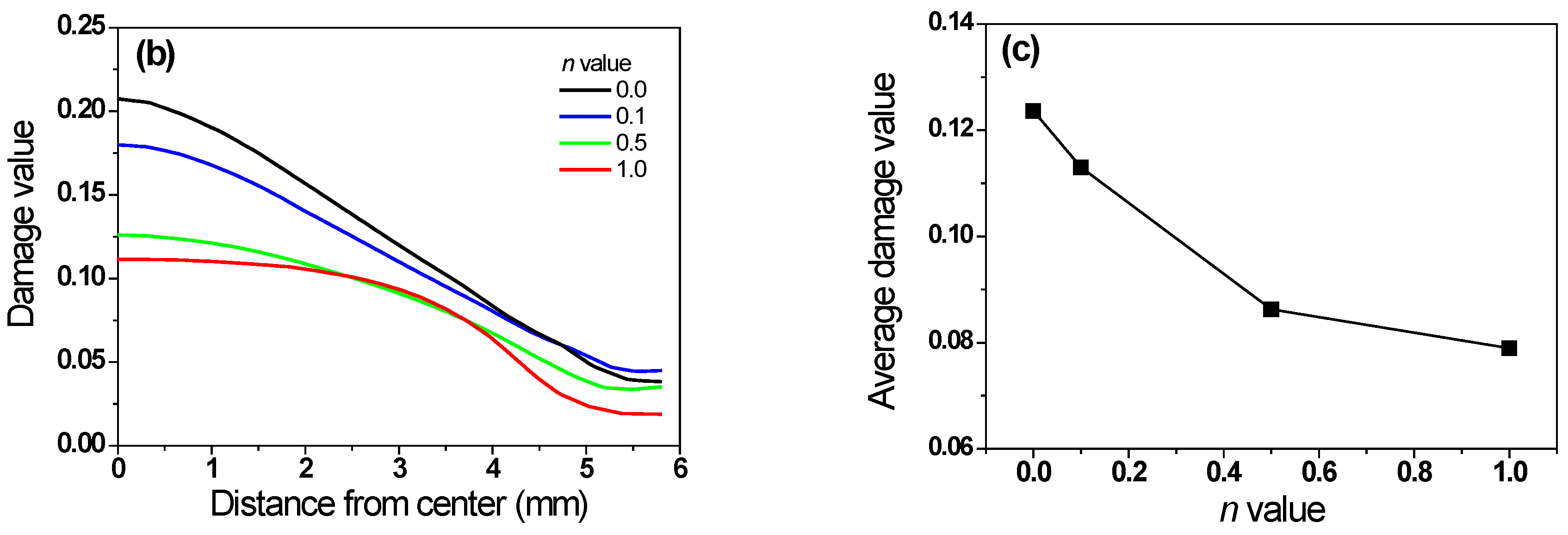


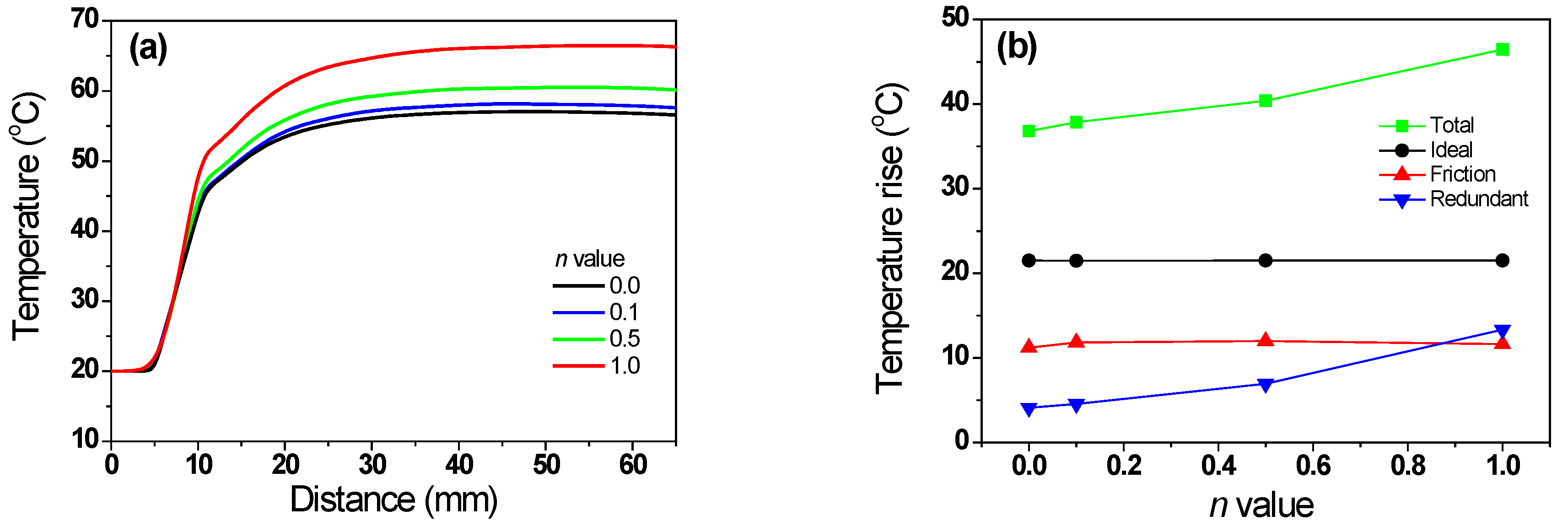
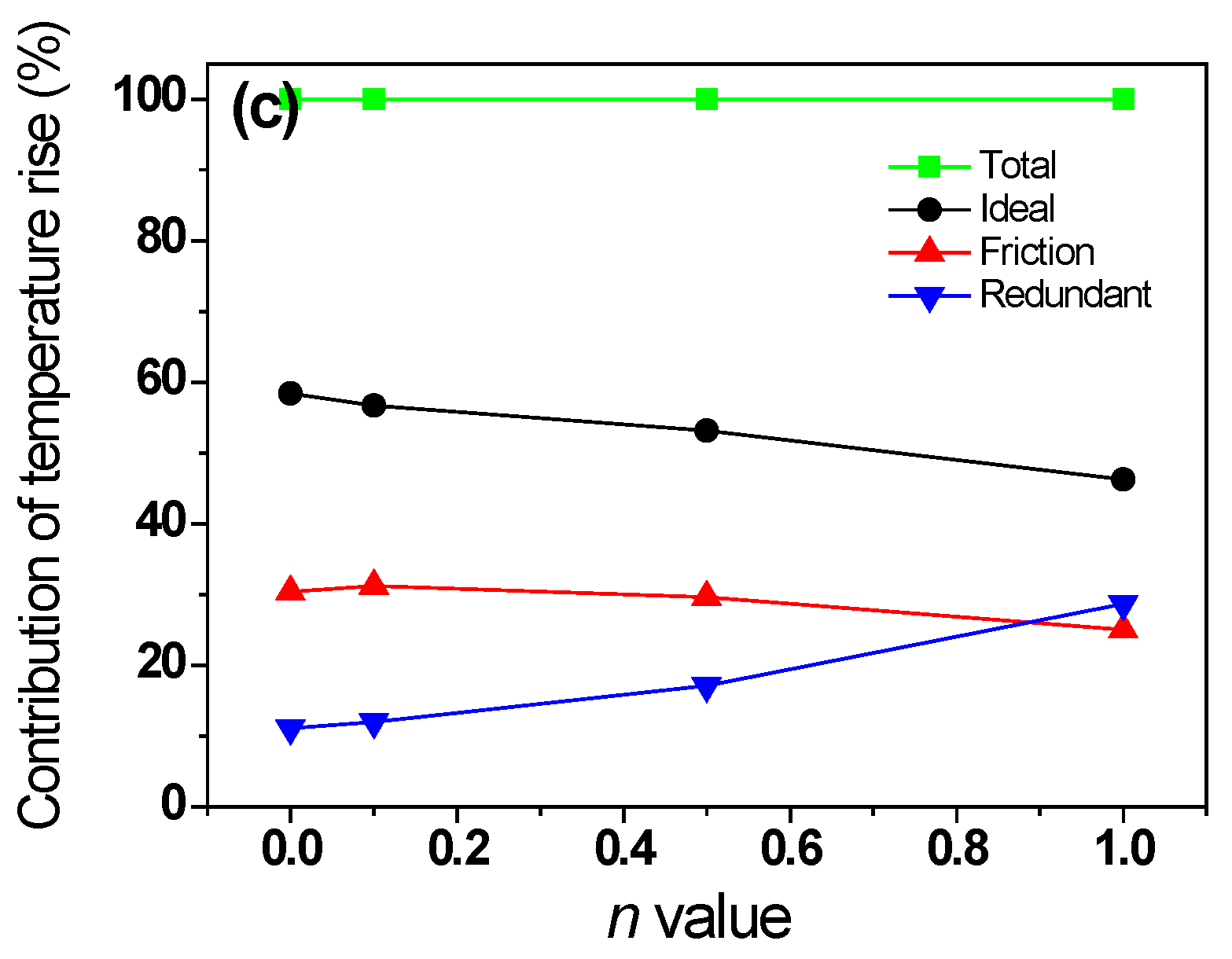
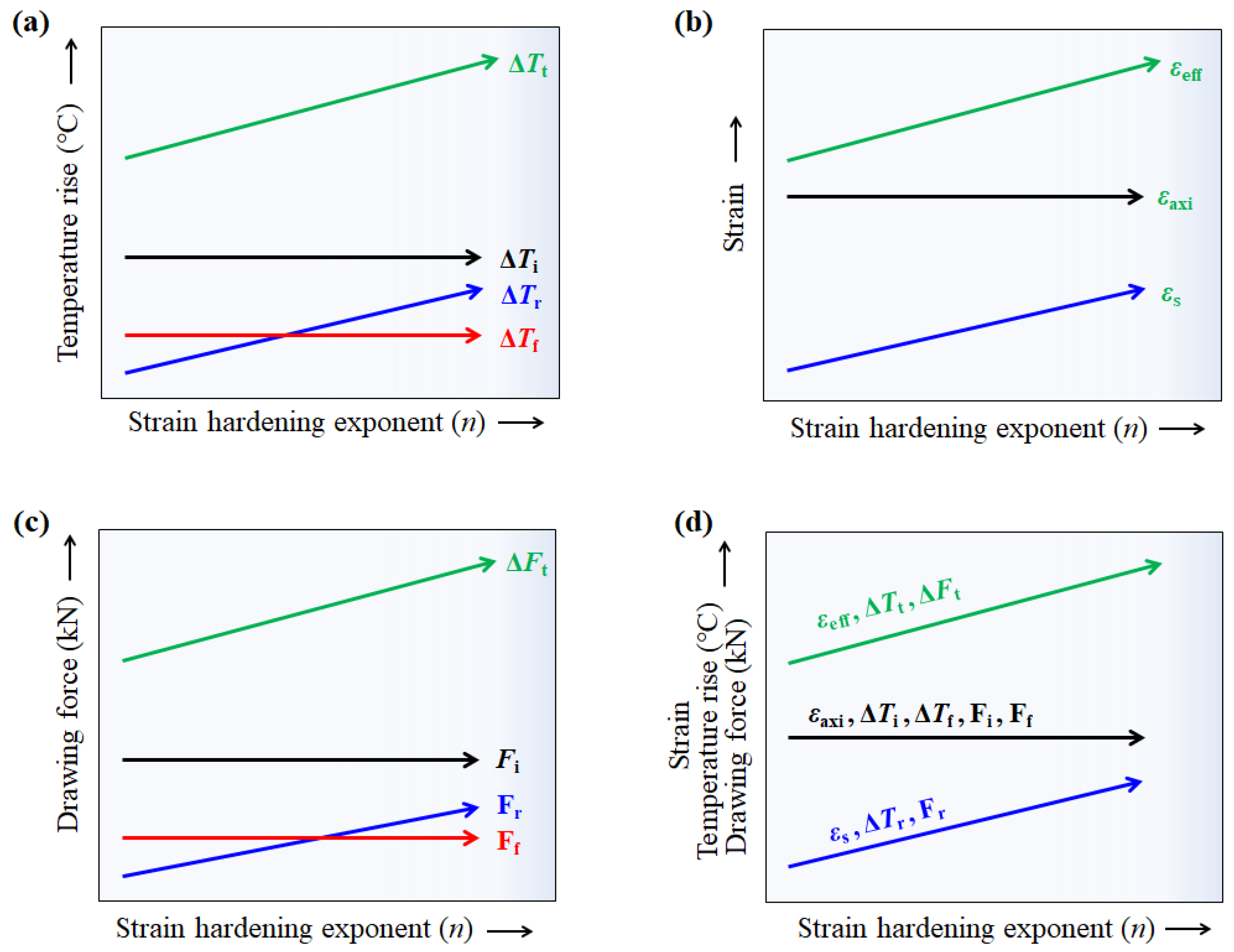
| Parameter | Value |
|---|---|
| Initial wire diameter (do) | 13.00 mm |
| Final wire diameter (df) | 11.63 mm |
| Reduction in area per pass (Rp) | 20% |
| Semi-die angle (θ) | 6° |
| Drawing velocity (Vd) | 0.07 m/s |
| Process Conditions | Wire Rod | Die |
|---|---|---|
| Thermal conductivity [k] (W/m/°C) | 59 [37] | 70 [38] |
| Heat capacity [ρCp] (N/mm2/°C) | 3.6 [36] | 3.6 |
| Fraction factor (ξ) | 0.9 | - |
| Material | Flow Stress (MPa) |
|---|---|
| Non-hardening wire | σ = 391ε0.0 |
| Low-hardening wire | σ = 500ε0.1 |
| High-hardening wire | σ = 1250ε0.5 |
| Linear-hardening wire | σ = 3554ε1.0 |
Disclaimer/Publisher’s Note: The statements, opinions and data contained in all publications are solely those of the individual author(s) and contributor(s) and not of MDPI and/or the editor(s). MDPI and/or the editor(s) disclaim responsibility for any injury to people or property resulting from any ideas, methods, instructions or products referred to in the content. |
© 2023 by the author. Licensee MDPI, Basel, Switzerland. This article is an open access article distributed under the terms and conditions of the Creative Commons Attribution (CC BY) license (https://creativecommons.org/licenses/by/4.0/).
Share and Cite
Hwang, J.-K. Influence of Strain Hardening Rate of Material on Temperature and Strain Distributions during Wire Drawing. Materials 2023, 16, 5203. https://doi.org/10.3390/ma16145203
Hwang J-K. Influence of Strain Hardening Rate of Material on Temperature and Strain Distributions during Wire Drawing. Materials. 2023; 16(14):5203. https://doi.org/10.3390/ma16145203
Chicago/Turabian StyleHwang, Joong-Ki. 2023. "Influence of Strain Hardening Rate of Material on Temperature and Strain Distributions during Wire Drawing" Materials 16, no. 14: 5203. https://doi.org/10.3390/ma16145203
APA StyleHwang, J.-K. (2023). Influence of Strain Hardening Rate of Material on Temperature and Strain Distributions during Wire Drawing. Materials, 16(14), 5203. https://doi.org/10.3390/ma16145203






